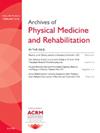在家庭健康中实施三步锻炼以支持患者功能结果:促进因素、障碍和初步发现4363
IF 3.6
2区 医学
Q1 REHABILITATION
Archives of physical medicine and rehabilitation
Pub Date : 2025-04-01
DOI:10.1016/j.apmr.2025.01.012
引用次数: 0
摘要
研究对象来自当地一家家庭医疗机构的康复治疗团队(1 名主任、3 名职业治疗师、5 名物理治疗师)和 10 名家庭医疗患者(平均年龄 77 岁;女性 5 人;白人 5 人)参与了研究。干预措施在实施修改后的 "生命锻炼三步骤"(包括结构化阻力锻炼和基于原则的活动锻炼)前后,对管理人员和治疗从业人员进行了个别访谈。根据访谈结果,在实施研究综合框架的指导下,采用定向定性内容分析法确定了实施障碍和促进因素。根据为每位患者提供的治疗服务类型,制定了不同的实施模式。主要结果测量患者的治疗结果通过急性期后护理活动测量法(Activity Measure for Post-Acute Care)和 EQ-5D-5L 进行评估,并使用 Wilcoxon 单秩检验进行分析。结果外部政策变化(即新的医疗保险支付模式)被认为是潜在的实施障碍,因为人们担心治疗次数会受到限制。然而,实施过程中发现了多种促进因素,包括干预措施的积极力量和质量、强大的内部机构网络和沟通、积极的办公室文化、干预措施的良好兼容性、对干预措施的充分了解和信念以及实施干预措施的自我效能感。结论虽然在实施前识别潜在障碍有助于修改干预计划,但在实施过程中也出现了其他障碍,如患者在计划完成前出院,或由于新的医疗保险支付模式导致符合条件的患者转诊发生变化。尽管家庭医疗患者可能会从 "生命锻炼三步曲 "计划中受益,但解决现有的实践习惯和了解新的医疗保险支付模式对于支持该计划的实施至关重要。本文章由计算机程序翻译,如有差异,请以英文原文为准。
Implementing 3-Steps Workout for Life to Support Patient Functional Outcomes in Home Health: Facilitators, Barriers, and Preliminary Findings 4363
Objectives
To investigate how to adapt the 3-Step Workout for Life, a task-oriented resistance exercise program, to be used by home health therapy practitioners.
Design
A mixed-methods action research design consisting of a single-site, pragmatic, quasi-experimental trial.
Setting
Home health care agency.
Participants
A rehabilitation therapy team (1 director, 3 occupational therapy practitioners, 5 physical therapy practitioners) and 10 home health patients (mean age, 77y; women, 5; White, 5) from a local home health agency participated in the study. Patients were excluded if they had a neurological condition or major surgical procedure.
Interventions
Individual interviews were conducted with administrators and therapy practitioners before and after the implementation of the modified 3-Step Workout for Life, which consisted of structured resistance exercise and principle-based activity exercise. Implementation barriers and facilitators were identified based on the interview results using directed qualitative content analysis, which was guided by the Consolidated Framework for Implementation Research. Different delivery models were developed to accommodate the type of therapy services provided to each patient. The modified 3-Step Workout for Life was implemented in eligible patients by the home health therapy team during in-person visits.
Main Outcome Measures
Patient outcomes were assessed with Activity Measure for Post-Acute Care and EQ-5D-5L, and were analyzed using the Wilcoxon singed-rank test. Patient satisfaction was measured using an exit survey.
Results
External policy changes (ie, the new Medicare payment model) were identified as a potential implementation barrier due to concerns about limited therapy visits. However, multiple implementation facilitators were identified regarding perceived positive strength and quality of the intervention, strong inner agency networks and communication, positive office culture, good compatibility of the intervention, great knowledge and belief about the intervention, and self-efficacy in delivering the intervention. Patients pre-post tests showed improved mobility (Z=−2.52, P=.01), daily activities (Z=−2.37, P=.02), and quality of life (Z=−1.87, P=.07).
Conclusions
Although identifying potential barriers before implementation was helpful in modifying the intervention program, additional barriers were raised during the implementation process, such as patients being discharged before program completion or changes in referrals of eligible patients due to the new Medicare payment model. Although home health patients may benefit from the 3-Step Workout for Life program, addressing existing practice habits and understanding the new Medicare payment model are crucial to support its implementation.
Disclosures
none.
求助全文
通过发布文献求助,成功后即可免费获取论文全文。
去求助
来源期刊
CiteScore
6.20
自引率
4.70%
发文量
495
审稿时长
38 days
期刊介绍:
The Archives of Physical Medicine and Rehabilitation publishes original, peer-reviewed research and clinical reports on important trends and developments in physical medicine and rehabilitation and related fields. This international journal brings researchers and clinicians authoritative information on the therapeutic utilization of physical, behavioral and pharmaceutical agents in providing comprehensive care for individuals with chronic illness and disabilities.
Archives began publication in 1920, publishes monthly, and is the official journal of the American Congress of Rehabilitation Medicine. Its papers are cited more often than any other rehabilitation journal.

 求助内容:
求助内容: 应助结果提醒方式:
应助结果提醒方式:


